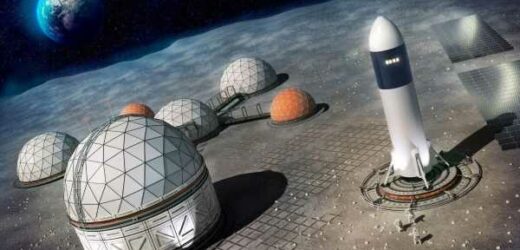China: Chang'e 5's space probe collects moon samples
We use your sign-up to provide content in ways you’ve consented to and to improve our understanding of you. This may include adverts from us and 3rd parties based on our understanding. You can unsubscribe at any time. More info
Soil on the surface of the moon could be used to help convert water and carbon dioxide into oxygen, hydrogen, and fuels like methane, components which could be used as sources of power and could provide habitable areas with a breathable atmosphere. Material scientist Professor Yingfang Yao of China’s Nanjing University said: “In the near future, we will see the crewed spaceflight industry developing rapidly. “Just like the ‘Age of Sail’ in the 1600s when hundreds of ships head to the sea, we will enter an ‘Age of Space’. “But if we want to carry out large-scale exploration of the extra-terrestrial world, we will need to think of ways to reduce payload, meaning relying on as little supplies from Earth as possible and using extra-terrestrial resources instead.”
NASA’s Perseverance Mars rover, for example, carries an experimental instrument known as the Mars Oxygen In-Situ Resource Utilization Experiment — or “MOXIE”, for short — that is capable of creating oxygen from carbon dioxide by means of solid oxide electrolysis.
However, MOXIE relies on a nuclear battery onboard the rover, transported with it to the Red Planet, in order to power the resource processing device.
In their study, however, Prof. Yao and colleagues propose to develop a comparable system that relies only on those resources found in abundance on the Moon — specifically, lunar soil and solar radiation — rather than relying on bringing materials from Earth.
Prof. Yao said: “We use in-situ environmental resources to minimise rocket payload, and our strategy provides a scenario for a sustainable and affordable extraterrestrial living environment.”


The researchers analysed samples of lunar soil brought back to Earth by China’s Chang’e 5 spacecraft, which landed on the Moon’s northwest near side on December 1, 2020 and returned just over two weeks later.
Prof. Yao and colleagues found the soil samples included various compounds — including both iron- and titanium-rich substances — which are capable, when powered by sunlight, of catalysing useful reactions.
Based on their findings, the team have proposed a so-called “extraterrestrial photosynthesis” system which would use these compounds in lunar soil to electrolyze water, extracted from both the moon and recycled from astronaut’s breathing exhausts into oxygen and hydrogen.
In addition, lunar soil could be used to combine carbon dioxide exhaled by astronauts with hydrogen to produce hydrocarbons such as methane — which can be used as fuel.


Because these processes need only be powered by sunlight, the researchers explained, they could easily be used to support life on a prospective future moonbase
The team have said that they are looking for an opportunity to test their system in space — potentially as part of one of China’s future crewed lunar missions.
In 2019, China announced that it was reviewing proposals to undertake a crewed lunar mission sometime during the 2030s.
And last year, the People’s Republic announced that it would be constructing a lunar research station in tandem with Russia.
DON’T MISS:
Shark mystery as super-rare ‘living fossil’ with 300 teeth found [REPORT]
Russia’s ‘only oil pipeline to EU’ in flames – 3 countries face crisis [INSIGHT]
How the UK, US and their allies could respond to a nuclear attack [ANALYSIS]
Prof. Yao does note that the catalytic efficiency of the compounds in lunar soil is less than the leading catalysts presently available on the Earth.
However, with their initial study complete, the team are now looking to explore potential approaches to improve the design of their system.
Such includes, for example, melting the lunar soil into a nanostructured, high-entropy material which would work more effectively as a catalyst.
The full findings of the study were published in the journal Joule.

Source: Read Full Article


